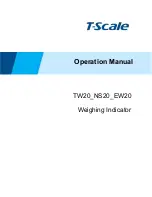
User Manual
User Manual
Ultrasonic Thickness Gauge and Meter
|
D1140772 • D1141137
Ultrasonic Thickness Gauge and Meter
|
D1140772 • D1141137
ULTRASONIC THICKNESS GAUGE AND METER | D1140772 • D1141137
- 14 -
ULTRASONIC THICKNESS GAUGE AND METER | D1140772 • D1141137
- 15 -
When using the ultrasonic thickness gauge, if the thickness of the material to be measured is less
than the minimum limit your will receive a faulty reading.
Always use a sample testing piece to know the minimum limit of the material being measured.
When measuring thin materials that are beyond the minimal limit, an error might occur where
the reading is double the actual thickness. To prevent this from happening ensure you know the
minimum limit of the material being measured.
5.1. Thin Materials
5.2. Rusty Surfaces
5.3. Re-calibrate when measuring different materials
5.4. Abrasions/Imperfections on the transducer
5.5. CAL (Calibration) Function
5. Precautions for Accuracy
Measuring rusty surfaces can result in incorrect reading. The material you are measuring may also
have rust on the inside of the pipe which can be hard to spot.
If you suspect that the material you are measuring has rust, make sure to make test measurement
from different spots, and angles to ensure you are getting an accurate reading.
A faulty reading will be obtained when measuring a new material if you have forgotten to re-
calibrate the velocity of the new material. Always re-calibrate the velocity when you are measuring
a new material.
The transducer is made of propylene, and after long periods of use the surface will become rough,
and decline in sensitivity, which can lead to inaccurate readings. Polish the transducer to and remove
rough spots and this will allow for accurate readings. If you are still getting inaccurate readings the
transducer should be replaced.
The
CAL
(calibration) button is used to calibrate the unit with the calibration piece on the panel. You
can also use this key to calibrate other materials.
The coupling agent will transmit the ultrasonic wave between the transducer and the gauge.
Selecting the wrong coupling agent for the job will lead to inaccurate readings. Typically a single drop
of couping agent will be sufficient.
It is important to use a low viscosity agent (this kit comes with low viscosity coupling agent) for
smooth surfaces, while a high viscosity agent (such as Glycerin) should be used on rough/vertical/
aluminum surfaces.
5.6. Multilayer and Composite Materials
5.7. Oxidized Surfaces
5.8. Abnormal readings
5.9. Selecting a coupling agent
Do not use this ultrasonic thickness gauge for measuring uncoupled multilayer objects as the wave
will not pass through. It also cannot be used for composite material since the wave will not travel
through the object at an even speed, the ultrasonic reflection principle will not be performed
properly.
Some metals such as aluminum will have an oxide layer, which will prevent the metal from oxidizing
further. This can sometimes lead to an inaccurate reading. The more oxidized the layer, the reading
will be more tolerant and produce a more accurate result. Please be aware of this when measuring
and then
Make sure to calibrate using a calibration piece that is the same material as what you are trying to
measure. You will also want to use a caliper/micrometer to obtain the actual thickness and input this
as you calibrate.
If you use an ultrasonic thickness gauges regularly you should be able to distinguish an abnormal
reading resulting from corrosion to the surface of objects or incorrect calibration. If you are new
to using this device, you will need to review the procedures in this manual to fix/avoid abnormal
readings.




























